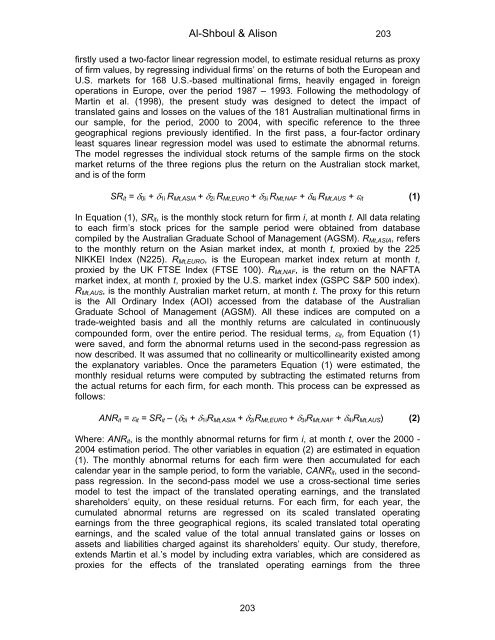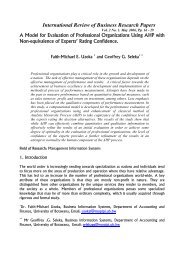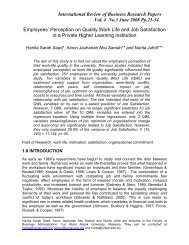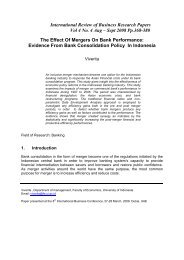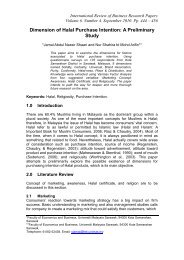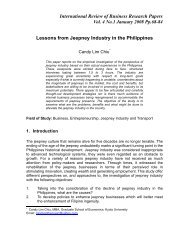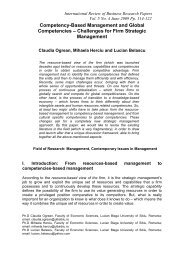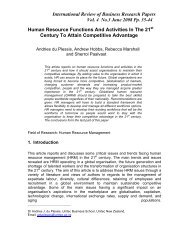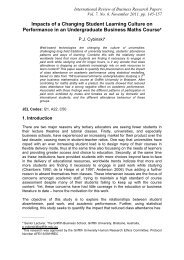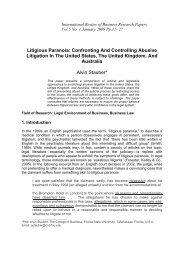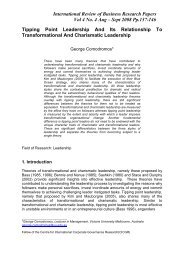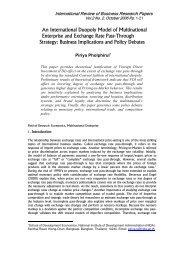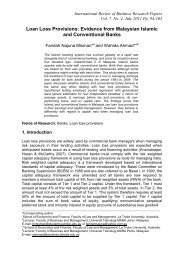Translation Exposure and Firm Value, Evidence From Australian ...
Translation Exposure and Firm Value, Evidence From Australian ...
Translation Exposure and Firm Value, Evidence From Australian ...
Create successful ePaper yourself
Turn your PDF publications into a flip-book with our unique Google optimized e-Paper software.
Al-Shboul & Alison 203firstly used a two-factor linear regression model, to estimate residual returns as proxyof firm values, by regressing individual firms’ on the returns of both the European <strong>and</strong>U.S. markets for 168 U.S.-based multinational firms, heavily engaged in foreignoperations in Europe, over the period 1987 – 1993. Following the methodology ofMartin et al. (1998), the present study was designed to detect the impact oftranslated gains <strong>and</strong> losses on the values of the 181 <strong>Australian</strong> multinational firms inour sample, for the period, 2000 to 2004, with specific reference to the threegeographical regions previously identified. In the first pass, a four-factor ordinaryleast squares linear regression model was used to estimate the abnormal returns.The model regresses the individual stock returns of the sample firms on the stockmarket returns of the three regions plus the return on the <strong>Australian</strong> stock market,<strong>and</strong> is of the formSR it = δ 0i + δ 1i R Mt,ASIA + δ 2i R Mt,EURO + δ 3i R Mt,NAF + δ 4i R Mt,AUS + ε it (1)In Equation (1), SR it , is the monthly stock return for firm i, at month t. All data relatingto each firm’s stock prices for the sample period were obtained from databasecompiled by the <strong>Australian</strong> Graduate School of Management (AGSM). R Mt,ASIA , refersto the monthly return on the Asian market index, at month t, proxied by the 225NIKKEI Index (N225). R Mt,EURO , is the European market index return at month t,proxied by the UK FTSE Index (FTSE 100). R Mt,NAF , is the return on the NAFTAmarket index, at month t, proxied by the U.S. market index (GSPC S&P 500 index).R Mt,AUS , is the monthly <strong>Australian</strong> market return, at month t. The proxy for this returnis the All Ordinary Index (AOI) accessed from the database of the <strong>Australian</strong>Graduate School of Management (AGSM). All these indices are computed on atrade-weighted basis <strong>and</strong> all the monthly returns are calculated in continuouslycompounded form, over the entire period. The residual terms, ε it , from Equation (1)were saved, <strong>and</strong> form the abnormal returns used in the second-pass regression asnow described. It was assumed that no collinearity or multicollinearity existed amongthe explanatory variables. Once the parameters Equation (1) were estimated, themonthly residual returns were computed by subtracting the estimated returns fromthe actual returns for each firm, for each month. This process can be expressed asfollows:ANR it = ε it = SR it – (δ 0i + δ 1i R Mt,ASIA + δ 2i R Mt,EURO + δ 3i R Mt,NAF + δ 4i R Mt,AUS ) (2)Where: ANR it , is the monthly abnormal returns for firm i, at month t, over the 2000 -2004 estimation period. The other variables in equation (2) are estimated in equation(1). The monthly abnormal returns for each firm were then accumulated for eachcalendar year in the sample period, to form the variable, CANR it , used in the secondpassregression. In the second-pass model we use a cross-sectional time seriesmodel to test the impact of the translated operating earnings, <strong>and</strong> the translatedshareholders’ equity, on these residual returns. For each firm, for each year, thecumulated abnormal returns are regressed on its scaled translated operatingearnings from the three geographical regions, its scaled translated total operatingearnings, <strong>and</strong> the scaled value of the total annual translated gains or losses onassets <strong>and</strong> liabilities charged against its shareholders’ equity. Our study, therefore,extends Martin et al.’s model by including extra variables, which are considered asproxies for the effects of the translated operating earnings from the three203


